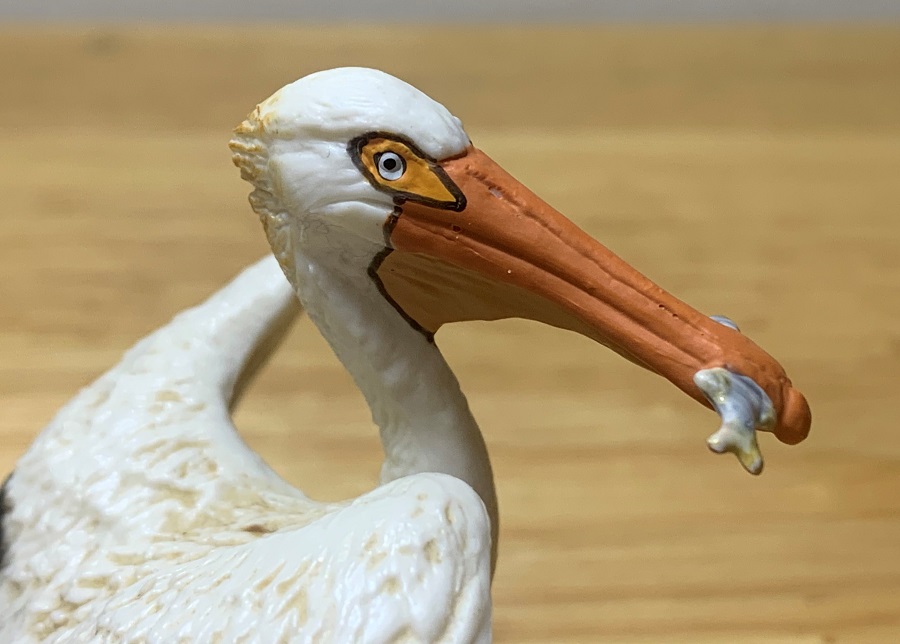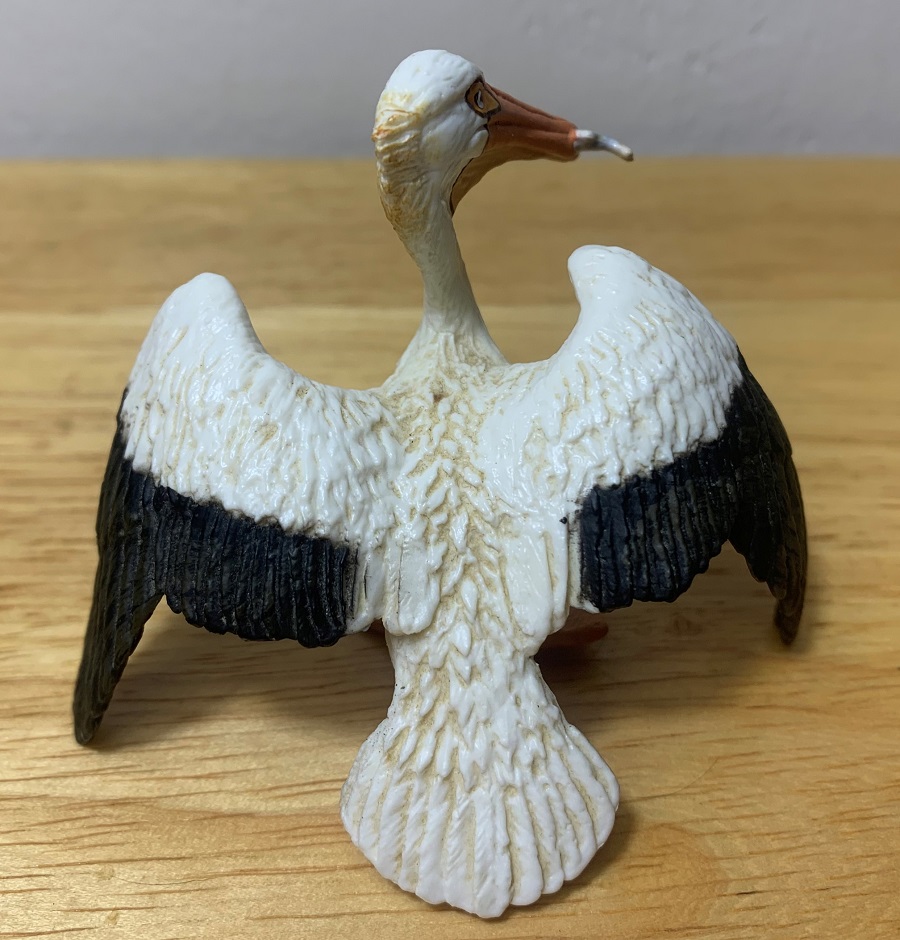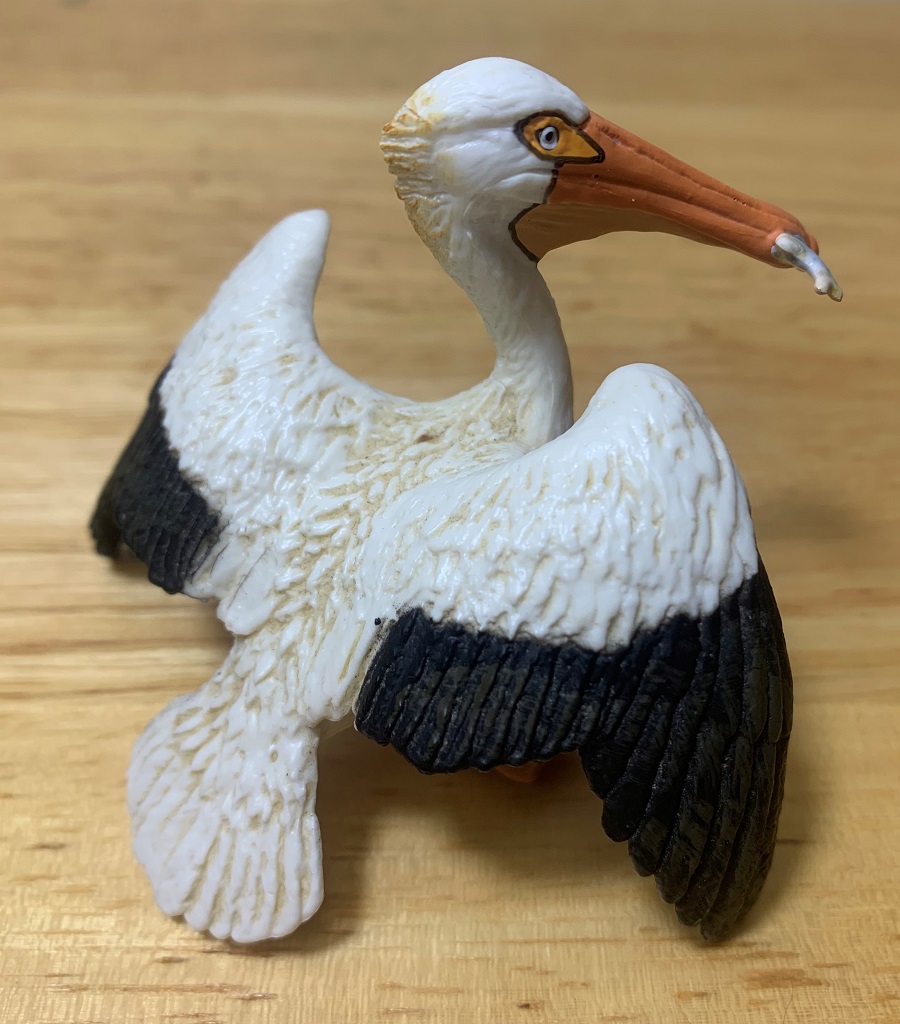The American white pelican (Pelecanus erythrorhynchos) is one of the largest birds in North America. Measuring 4-6’ (1.2-1.8 meters) in length, only the trumpeter swan matches it in length. With a wingspan of 8-10’ (2.4- 3 meters), only the California condor has a wider spread. Such a wingspan is required because the white pelican is also a heavy bird, weighing 11-20 lbs. (5.0-9.1 kg). Today we’re looking at the Safari white pelican. Produced in 2004 it was retired in 2014 and has since been replaced by another white pelican.

This Safari white pelican represents one of my first forays into extant animal collecting. Being a veteran dinosaur collector, I thought it would be fun to throw a few extant birds on my theropod shelf. This pelican was my first extant animal figure obtained as an adult.

Since figuring out the scale of bird figures can be a frustrating process, I decided to just use the bill length for this one. Much of the white pelican’s body length can be attributed to its enormous bill which can measure 11.3–15.2” (28- 38 cm) in males and is generally slightly smaller in females. The Safari figure’s bill measures an inch (2.54 cm) so that puts the figure at 1/11-1/15 in scale. The figure stands about 2.25” (5.7 cm) tall and measures 3” (7.6 cm) wide.

The American white pelican breeds in scattered pockets throughout the upper mid-west and western portions of North America. In the winter they migrate to the coasts of the southern U.S. and Central America. I count myself lucky in that within recent years a colony of white pelicans have established themselves at my local wildlife refuge in Maryland.

The Safari white pelican is presented in a perched posture with its wings outstretched and head looking rightward. A small fish is clasped within its beak. White pelicans pursue their prey by herding fish around in shallow water, as a group, dipping their bills underwater and scooping up their prey. This differs from the brown pelican which dives for its prey.

If I were hard pressed to identify the fish, I would tentatively identify it as a mooneye (Hiodon tergisus), with its silvery-blue compressed body, large golden eyes, and dorsal fin position. Chances are that it doesn’t represent any species in particular and I would be surprised if it were actually a mooneye but that’s what I want it to be.

Although now 17 years old the Safari white pelican is still a splendid figure that looks as good as any of Safari’s modern bird figures. It’s sculpted by Safari regular Doug Watson so quality shouldn’t really be a question here. The feathers are exceptionally well sculpted and detailed. A small crest of feathers is sculpted on the back of the head and the feathers along the back are slightly ruffled. The bill pouch is somewhat saggy with folds sculpted around it.

The figure is painted to look like a breeding adult with its vibrant coloration around the face, but lacks the vertical crest atop the beak that occurs in breeding adults. The American white pelican is the only pelican species to grow such a crest and the crest falls off after mating and egg laying. Safari also released a brown pelican at the same time as this one, it is the exact same sculpt only painted with the brown pelican’s colors, for that figure the crest wouldn’t have worked.

The figure has a white body, black and white wings, orange bill and feet, and white eyes. The edge of the beak and area around the eyes are outlined in black. My figure has a faint brown wash over the white feathers, but I’ve also seen variants of this toy without it.
Safari released a replacement for this figure in 2016 but I don’t know that it was necessary as they’re both remarkably similar. The newer figure has basically the same pose but lacks the fish, and still lacks the crest on the bill. Safari might as well have kept this one in production. Hopefully Safari eventually releases another brown pelican as that one hasn’t been replaced and is now rare and coveted.
Disclaimer: links to Ebay and Amazon on the AnimalToyBlog are affiliate links, so we make a small commission if you use them. Thanks for supporting us!




Wonderful Gwangi. I have the updated version without the fish, but I do have the brown pelican which is this same sculpt (with fish)
I’m happy Safari replaced this figure with one that doesn’t have prey in its mouth, as I don’t want figures with accessories permanently attached to them. I have the newer Safari pelican and I like it a lot. I too would like a brown pelican from Safari, even it it’s a repaint of their current pelican.
I tend to agree, I don’t like accessories permanently attached either. I didn’t care as much when I bought it, which was on impulse and just to cheekily put on my theropod shelf. It doesn’t bother me enough to replace the figure though.